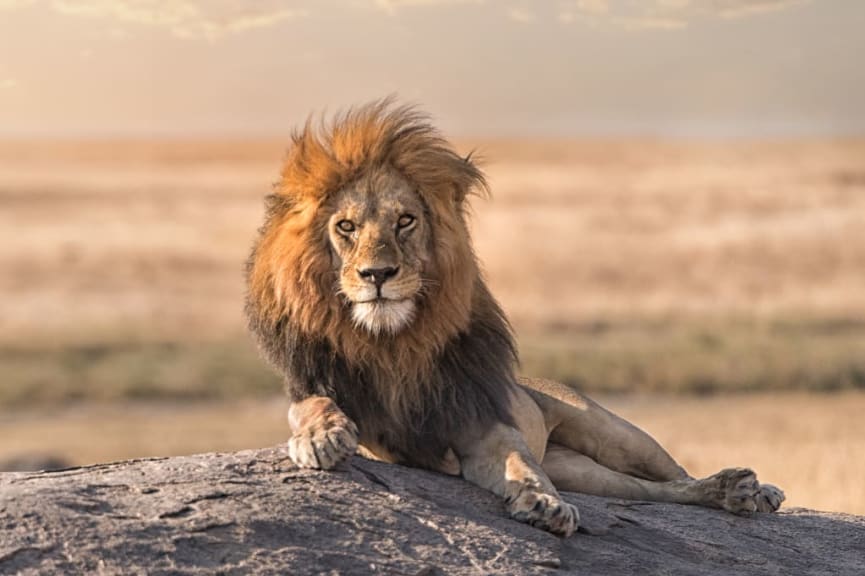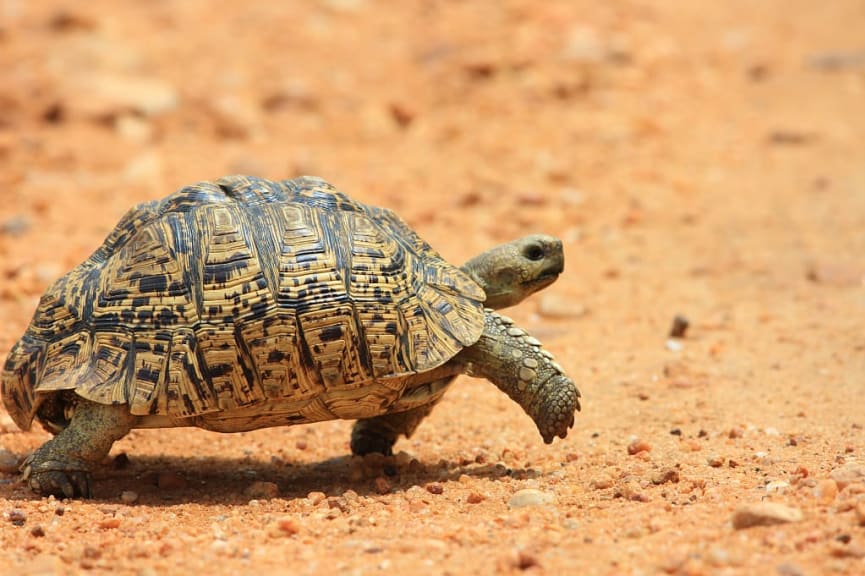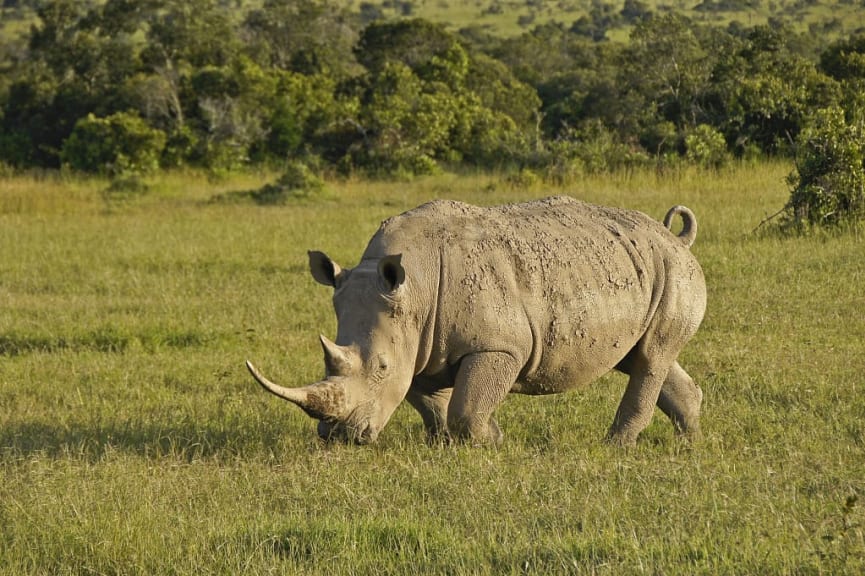The Big Five, the Little Five, and How to See Them

Leopard in Botswana
Anyone looking to embark on an African Safari has heard the term “The Big Five,” but not everyone has heard of the “Little Five.” The Big Five are often the highlight of an African safari, and earning more about these animals and their place in the savanna is an essential part of any safari experience. Your knowledgeable guides will aim to take you on the adventure of your life as you discover the wonder of these incredible animals and so many more.
What is the Big Five?

Lion in Serengeti, Tanzania
A lion's mane flickering in the tones of sunset, the alpha male content amongst his graceful lionesses. The sight of elephants roaming free, melodic footsteps across a vast interrupted plain. Buffalos in shabby unison, their unrelenting stares indicative of power, mouths constantly chewing and churning as they face you down. Now a rhino, an elegance radiating from their slow journey past the safari vehicle, horns delightfully pointed with markers of grace. Then the leopard, the most elusive, the intelligent predator hiding in the trees. Spot these animals up close, and these sights will stay in your memories many decades later.
It is often difficult to get away from the notion of a safari checklist, especially if it's your first time on safari. Come to Africa, and there are certain animals you will be desperate to see. Return from a safari, and people will ask whether you saw the Big Five. And most will hope that you were successful in your quest. But what does that mean? After all, are you quite sure that the leopard you spotted up a tree was not actually a branch covered in dark foliage? That buffalo up on the hill, not a strategically placed rock?
The best safari memories are not preconceived. Instead, they are the surprises, intimate moments that are meaningful to you. That could include one of the Big Five or an encounter of a different kind. Maybe a cheetah is accelerating towards an impala, a sweet zebra pair grooming each other, or the exciting sight of a hippo out of the water.
Most game drives are in a 4x4 vehicle on both day and night drives. However, there are other options you can consider. Some lodges offer walking safaris, the opportunity to immerse yourself in the bush as you learn about the land while waiting to spot one of Africa’s incredible creatures. Nothing beats searching for the Big Five and more from above as you soar high above the park or reserve in a hot air balloon. For those looking to stay in, marvel as animals come to the lodge’s waterhole or from a well-hidden hide a short distance from your room.
What is the Little Five?

Leopard tortoise in Zambia
Nature conservations started promoting the Little Five, enigmatic and cute creatures that emphasized the diversity of the African landscape. Each is a dramatic contradiction in size while maintaining part of the name. There's the elephant shrew, an impossibly cute rodent that jumps across Southern African savanna with strange shocks of color; the buffalo weaver, a busy little bird whose distinctive nests are easy to find; the leopard tortoise, named for a shell with similar markings to the cat; the tiny lion ant; and the armor shaped rhino beetle, another that regularly goes unseen.
These tiny creatures are unlikely to be the highlight of a safari, but they do broaden your perspective. Anyone able to see both the Big Five and Little Five on a single safari has done exceptionally well, which is part of the argument. With so much to discover, a narrow focus on the Big Five seems to miss the point. An encounter with these fascinating animals will surely add to the overall joy and excitement of a game drive, even if their larger sidekicks may be missing from action that day.
South Africa proudly presents safari guides of the highest caliber. If it happens to be a quiet day in the bush, your guide can find nature’s miracles all around. On a typical safari, you would have more chance of coming across the rhino beetle or buffalo weaver, with sightings of the elephant shrew less common but found all around the country. The gorgeous leopard tortoise likes to call the Cape Province home, and the challenging chap, the antlion, is a rare find, but your guide will try to track one down for you if asked.
What to Expect on Safari

Lion in Serengeti, Tanzania
How could you summarize the vast quantity of animals that are spotted or the unusual and eclectic range of wildlife that's alive on Africa's untrammeled landscapes? The alternative lies in evoking the origins of safari, a Swahili word meaning “long journey.”
Focusing completely on the Big Five makes the experience objective, suggesting something like being in a zoo, wandering around to check off the animals you expect to see. But a journey implies something unpredictable and surprising. No two journeys are ever the same, regardless of how many times you make them.
Thinking about a “long journey” moves the emphasis away from anticipated sights to what you experience. Certain preconceptions are retained, but the daydream becomes a blank canvas that can be painted with a multiplicity of tones and colors. Safaris are intimate and personal, not merely the same photos and sights of everyone else. Viewing the safari as a journey celebrates the inimitability of the experience.
How Does the Big Five Help Conservation?

White rhinoceros in Ol Pejeta Conservancy, Kenya
Somewhat ironically, what started as a hunting term has become an aid for conservation. National parks and reserves have been reintroducing species that had become locally extinct. Huge effort and funding have gone towards preserving these majestic icons of Africa.
In particular, rhinos are found in far more reserves than they were just a decade ago. These five have a visibility that makes them essential to the tourism industry, driving conservation efforts across the whole continent. Protecting and preserving the Big Five not only secures their future in the African wild, but in turn ensures a safe and preserved environment for many more. There are some excellent success stories to discover on an African safari, including rehabilitation programs and reintroduced species.
Including local communities plays an integral part in a lodge or private reserve’s success. Giving back is a huge focus, and ways of doing this include employing local residents, supporting community-driven food projects, training locals to become excellent guides, and creating a center where young and old can learn, receive and give back. With most lodges embracing this relationship, you can confidently pick your lodge of choice, knowing you are playing a role in maintaining environmental and community sustainability.
Get your Safari Plans Started

Masai Mara, Kenya
There are many ways to begin your safari plans, and the best way is to connect with a Zicasso safari specialist. With deep knowledge of each country and how to best experience the wildlife, your safari specialist can offer helpful advice. Find more inspiration with our Africa Safari Travel Guide, fill out a Trip Request, or call our Traveler Care team at 1-888-265-9707.
Life-Enriching Travel Designed Just for You
- 1
Trips curated by the world’s top destination experts
- 2
Concierge-level service leading up to and during your trip
- 3
Unique, exclusive experiences and insider access

